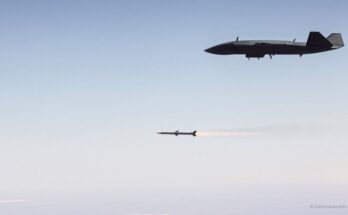by Shaun McDougall, Military Markets Analyst, Forecast International.
Lockheed Martin has been awarded a contract worth up to $480 million for the conduct of a Critical Design Review and to provide test and production readiness support for the U.S. Air Force’s Air-Launched Rapid Response Weapon (ARRW, pronounced “Arrow”), one of the service’s ongoing hypersonic weapon development efforts. The Air Force is obligating $5 million at time of award. Contract work will be performed in Orlando, Florida, and is expected to be completed by November 30, 2021.
The ARRW program is leveraging work from a separate Air Force/DARPA hypersonic effort called Tactical Boost Glide. Boost glide vehicles use a rocket to accelerate to hypersonic speeds, then separate from the rocket and glide unpowered to their target. Early work on ARRW was actually made possible through the original TBG contract, and in this regard, ongoing work on TBG will serve as a risk reduction effort for ARRW. The ARRW weapon has been referred to as the AGM-183A.
The program “integrates Air Force and [Defense Advanced Research Projects Agency (DARPA)] enabled system technologies into a prototype that will demonstrate the viability of this concept to be fielded as a long range prompt strike capability,” according to a description in the FY19 budget. “ARRW will design, develop, manufacture, and test a number of prototype vehicles to inform decisions concerning ARRW acquisition and production.” The Air Force requested $168.7 million for this work in FY19.
ARRW is one of two new prototyping efforts the Air Force is pursuing in order to accelerate the fielding of a hypersonic weapon in response Chinese and Russian advancements in this arena. The second program is the Hypersonic Conventional Strike Weapon (HCSW – or “Hacksaw”), for which the Air Forced requested $83.9 million in FY19. HCSW will be a hypersonic, conventional, air-launched, standoff weapon. Lockheed Martin was awarded a contract in April 2018 worth up to $928 million to develop this high-speed cruise missile. Compared to ARRW, HCSW will have a different flight profile and payload capacity, and the Air Force describes the two weapons as offering complementary capabilities.
Both ARRW and HCSW are part of the Hypersonics Prototyping project within the Pentagon’s broad Technology Transition Program. In its markup of the FY19 defense spending bill, the Senate Appropriations Committee recommended including separate lines in the Air Force’s budget for these hypersonic efforts in order to increase transparency and oversight.
Another one of the projects in the Technology Transition Program is the Advanced Full Range Engine (AFRE), which aims to demonstrate a hybrid propulsion system that would utilize a traditional turbine engine and transition to a Dual Mode Ramjet (DMRJ) for hypersonic travel. Ground tests are planned for 2019 or 2020. This is a joint effort between DARPA and the National Aeronautics and Space Administration (NASA).
The Air Force has another hypersonic engine development effort called the High-Speed Air-breathing Weapon Concept (HAWC), which aims to demonstrate the use of a scramjet engine on a hypersonic missile, and follows work done on the X-51.
The Army and Navy are also working on developing hypersonic capabilities. The Army is working with DARPA on studying a ground-launched capability for hypersonic boost glide weapons through the Operational Fires project. This effort was funded at $6 million in FY18 and $50 million in the FY19 request. Operational Fires will also leverage work done on the Air Force TBG program. The Army was previously conducting work on the Advanced Hypersonic Weapon. A successful flight test was conducted in November 2011, but an August 2014 flight test failed due to a problem with the booster rocket used to launch the glide vehicle.
The Navy was tasked with a follow-on test using a downsized hypersonic vehicle. Downsizing provides the Navy with the ability to analyze possible future ship-launched capabilities. The Navy’s Strategic Systems Programs office conducted this test, dubbed Flight Experiment-1, in October 2017. A rocket carrying the glide vehicle was launched from Hawaii, after which the glide vehicle flew more than 2,000 miles in about 30 minutes. Other details of the test were classified.
The FY19 budget includes another $278.4 million for hypersonic glide experiments and concepts demonstration support as part of the Prompt Global Strike Capability program. This program is funded primarily through the Office of the Secretary of Defense in FY19, but will be transitioning to the Navy in FY20 as part of the service’s Precision Strike Weapons Development program.
As editor of International Military Markets, North America, Shaun has cultivated a deep understanding of the vast defense markets in the United States and Canada. Further, Shaun played an integral role in the development of Forecast International’s U.S. Defense Budget Forecast product, which offers an unprecedented level of insight into the Pentagon’s acquisition budget.
For 50 years, Forecast International intelligence reports have been the aerospace and defense industry standard for accurate research, analysis, and projections. Our experienced analysts compile, evaluate, and present accurate data for decision makers. FI's market research reports offer concise analysis of individual programs and identify market opportunities. Each report includes a program overview, detailed statistics, recent developments and a competitive analysis, culminating in production forecasts spanning 10 or 15 years. Let our market intelligence reports be a key part of reducing uncertainties and mastering your specific market and its growth potential. Find out more at www.forecastinternational.com



